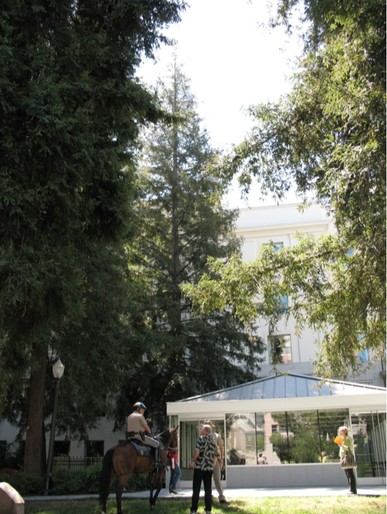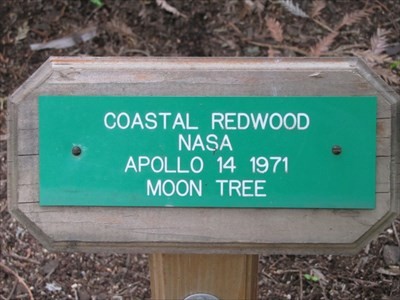"Moon Tree" at California State Capitol Park
Introduction
Text-to-speech Audio
Located on the grounds at California State Capitol Park, the "Moon Tree" is a California redwood (Sequoia sempervirens) that was grown from one of hundreds of seeds which orbited the moon during the Apollo 14 mission in 1971. The seeds were taken into space in order to study the effect of prolonged weightlessness on seed germination and sapling growth. Afterwards, the seeds were cultivated by the U.S. Forestry Service Genetics Laboratory. In the mid-1970s, the saplings were planted at various locations around the country, with this particular "Moon Tree" taking root in Sacramento on the grounds of California State Capitol Park.
Images
The "Moon Tree" at California State Capitol Park

Coastal Redwood "Moon Tree" Marker

Backstory and Context
Text-to-speech Audio
In 1966, Carl Fowler collected seeds from a coast redwood (Sequoia sempervirens) near his home in Soquel, located in Santa Cruz County. Fowler then sent the seeds to the U.S. Forest Service's Institute of Forest Genetics (IFG), which received and cataloged them as accession "Lot X." Approximately five years later, in 1971 some five-hundred seeds from Lot X were transferred to Dr. Charles H. Walkinshaw at the U.S. Department of Agriculture, who was working on a special assignment at the Johnson Space Center in Houston.
On behalf of NASA, Dr. Walkinshaw was overseeing the Space Center's Lunar Receiving Laboratory when he received the coast redwood seeds from Lot X, in addition to seeds from several other tree species, including Douglas fir, loblolly pine, sycamore, and sweetgum trees. In 1971, Lt. Cdr. Stuart Roosa, a U.S. Air Force Pilot and U.S. Forest Service "smokejumper" trained to fight wildfires, chose to take a selection of these seeds with him during the Apollo 14 mission, on which he embarked with fellow NASA astronauts Alan Shepard and Edgar Mitchell.
In preparation for transport into space, the seeds were carefully packed in sealed containers. Launching from the Kennedy Space Center in Florida on January 31, 1971, the Apollo 14 mission became the third crewed mission to land on the moon and to explore the lunar surface. Shepard and Mitchell walked on the moon, while Stuart Roosa orbited in the command module above. From January 31 until February 9, 1971, the seeds that he carried with him into space also orbited the moon a total of thirty-four times, as part of a joint project between NASA and the U.S. Forest Service.
Yet upon returning to Earth, the seed container burst during the decontamination process. As a result, seeds from the different tree species became scrambled and were exposed to a vacuum. Fortunately, after inspection, most were found to have sustained virtually no damage during or after transport, pointing to their remarkable capacity for resiliency. They were sorted out, and the historic collection of seeds was returned to the U.S. Forest Service's Institute of Forest Genetics for cultivation into saplings. Under carefully monitored conditions, many of the seeds were able to thrive, emerging into saplings that became known as "Moon Trees."
A special celebration for the Moon Trees followed, in conjunction with state foresters from forty states where the saplings were sent to be planted. Dedication ceremonies were held at various locations, including on the grounds of the California State Capitol Park in Sacramento, where a redwood sapling was planted next to the Capitol Building. According to a 1976 news story, each Moon Tree was intended to represent the dual themes of "Horizons and Heritage." In addition to commemorating a successful space mission, the Moon Trees were also planted in honor of the U.S. Bicentennial in 1976, and some were given as gifts to other nations.
Sources
"Capitol 'Moon Tree': Symbolic of forests in Space Age." The Uklah Daily Journal (Uklah, California), April 21st, 1976.
Capitol Park Tree Booklet, Capitol Museum. Accessed July 10th, 2023. https://capitolmuseum.ca.gov/images/pdf/CapitolParkTreeBooklet.pdf.
"Moon Tree Accession Documents: U.S. Forest Service", NASA. Accessed July 10th, 2023. https://nssdc.gsfc.nasa.gov/planetary/lunar/moon_trees/moon_tree_accession_doc.html.
Scrambler, Cajun. "Moon Tree: Planted in 1976", Historical Marker Database. June 29th, 2019. Accessed July 10th, 2023. https://www.hmdb.org/m.asp?m=135981.
"Stuart Roosa and the Moon Tree Seeds", NASA. Accessed July 10th, 2023. https://nssdc.gsfc.nasa.gov/planetary/lunar/moon_trees/roosa_moon_tree_seeds.html#seeds.
"The Moon Trees", NASA. Accessed July 10th, 2023. https://nssdc.gsfc.nasa.gov/planetary/lunar/moon_tree.html.
California State Capitol Museum Tree Booklet
Waymarking
